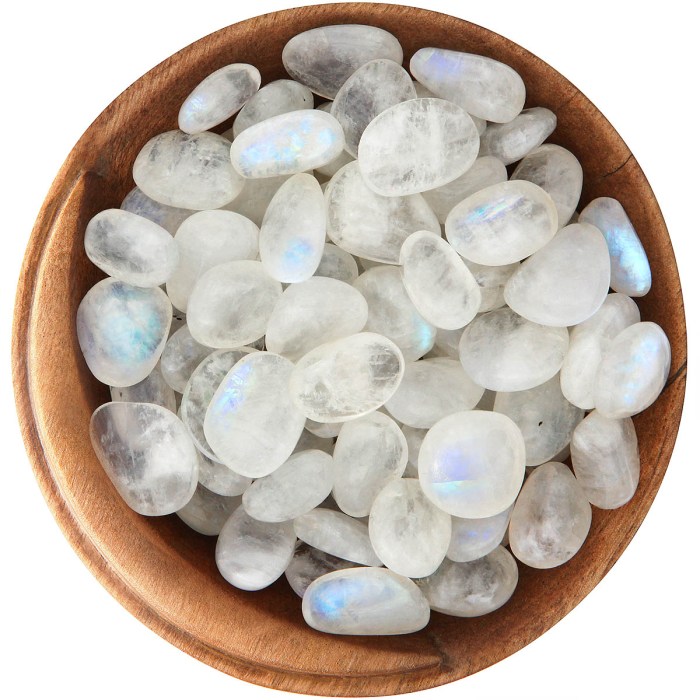Moonstone where to find – Embark on a journey to discover the enchanting world of moonstone, uncovering its geological origins and embarking on an exploration of the regions where this ethereal gemstone graces the earth. Dive into the captivating characteristics of moonstone, unraveling its varieties, shimmering optical properties, and factors influencing its value.
As we delve into the intricacies of moonstone mining, extraction, and environmental impact, you’ll gain a profound understanding of the challenges and practices involved. Explore the historical and cultural significance of moonstone, tracing its use in jewelry, art, and decorative objects.
Delve into the metaphysical and spiritual beliefs associated with this gemstone, uncovering its profound connection to the moon and its cycles.
Our comprehensive guide culminates with practical advice on identifying genuine moonstone, assessing its quality, and determining its value. Whether you’re a seasoned gemstone enthusiast or simply captivated by the allure of moonstone, this guide will illuminate your path, providing a wealth of knowledge and insights.
Moonstone Origins and Locations
Moonstone is a feldspar mineral that forms when magma cools slowly. It is composed of orthoclase and albite, and its unique adularescence is caused by the presence of tiny inclusions of albite within the orthoclase.Moonstone is found in many countries around the world, including:
- India
- Sri Lanka
- Madagascar
- Brazil
- United States
- Australia
The most famous moonstone mines are located in India, where the mineral has been mined for centuries. The mines in the southern Indian state of Tamil Nadu are particularly well-known for producing high-quality moonstone.
Moonstone Varieties and Characteristics

There are several different types of moonstone, each with its own unique color and transparency. The most common type of moonstone is white, but it can also be found in shades of blue, green, yellow, and orange. Transparent moonstone is called “adularia,” while opaque moonstone is called “rainbow moonstone.”Moonstone’s most distinctive feature is its adularescence, which is a shimmering effect that is caused by the reflection of light from the tiny inclusions of albite within the orthoclase.
The adularescence of moonstone can be blue, white, or rainbow-colored.The value of moonstone is determined by its size, clarity, and color. The larger and clearer the moonstone, the more valuable it is. Blue moonstone is the most valuable type of moonstone, followed by white moonstone and rainbow moonstone.
Moonstone Mining and Extraction
Moonstone is mined using a variety of methods, including:
- Open-pit mining
- Underground mining
- Alluvial mining
Open-pit mining is the most common method of mining moonstone. In this method, a large pit is dug into the ground, and the moonstone is extracted from the pit using heavy machinery. Underground mining is used to extract moonstone from deep underground deposits.
In this method, a shaft is dug into the ground, and the moonstone is extracted from the shaft using machinery. Alluvial mining is used to extract moonstone from riverbeds and other alluvial deposits. In this method, the moonstone is extracted from the sediment using a variety of methods, such as panning and dredging.Moonstone mining can be a dangerous and challenging process.
The mines are often located in remote areas, and the miners often have to work in difficult conditions. The miners also face the risk of being injured or killed by falling rocks or other accidents.
Moonstone Uses and Applications

Moonstone has been used in jewelry and other decorative objects for centuries. It is a popular choice for rings, necklaces, earrings, and bracelets. Moonstone is also used in carvings, sculptures, and other works of art.In addition to its use in jewelry and art, moonstone is also used in a variety of metaphysical and spiritual practices.
It is believed to have a calming and soothing effect, and it is often used in meditation and other spiritual practices. Moonstone is also believed to have a number of healing properties, including the ability to promote fertility, relieve stress, and improve sleep.
Moonstone Identification and Value

Moonstone can be identified by its adularescence and its hardness. Moonstone has a hardness of 6 on the Mohs scale, which means that it can be scratched by a steel file. Moonstone can also be identified by its specific gravity, which is 2.6-2.7.The value of moonstone is determined by its size, clarity, and color.
The larger and clearer the moonstone, the more valuable it is. Blue moonstone is the most valuable type of moonstone, followed by white moonstone and rainbow moonstone.When buying moonstone, it is important to be aware of imitations. Some imitations are made of glass or plastic, while others are made of natural materials that have been treated to resemble moonstone.
It is important to buy moonstone from a reputable dealer who can guarantee the authenticity of the stone.
FAQ Summary: Moonstone Where To Find
Where is moonstone primarily found?
Moonstone is predominantly found in Sri Lanka, India, Madagascar, Brazil, and the United States (specifically North Carolina).
What factors determine the value of moonstone?
Size, clarity, color, and the intensity of adularescence (shimmering effect) are key factors that influence the value of moonstone.
How can I identify genuine moonstone?
Examine the stone under a light source; genuine moonstone will exhibit a distinct shimmering effect known as adularescence. Additionally, consult with a reputable jeweler or gemologist for professional identification.
What metaphysical properties are associated with moonstone?
Moonstone is believed to possess calming and soothing energies, promote emotional balance, enhance intuition, and foster spiritual growth.
How is moonstone typically used in jewelry?
Moonstone is commonly used in necklaces, earrings, bracelets, and rings. Its ethereal shimmer complements a variety of metals, including silver, gold, and platinum.
